Democracy, or a Sketch of the Life of Buonaparte
This is an exceptional print in many ways. It is one of only two prints in Gillray's work which, so far as I am aware, uses a multi-panel sequence of images to tell a story. The other being the four-panel John Bull's Progress (1793).
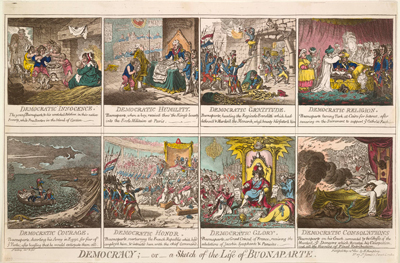
© Trustees of the British Museum
Gillray had, of course been using multi-panel prints in other ways from as early as 1782. But until 1792, those had been two-panel prints showing a contrast between two objects or two states of the same object, such as Minister In. Minister Out (1782), France Freedom. Britain Slavery (1789), or The National Assembly Petrified. The National Assembly Revivified (1791. In 1792, for the first time, he created a four-panel print, Vices Overlook'd in the New Proclamation (1792), but like the later National Conveniences (1796) and Patriotic Petitions (1808), each panel is a discrete example of a common object—a vice, a convenience or a petition. There is no sequence or story.
With John Bull's Progress (1793), Gillray, for the first time, followed a set of characters—John Bull and his family, charting their "progress" from contentment to ruin in four snapshots over time and powerfully demonstrating the human costs of war.
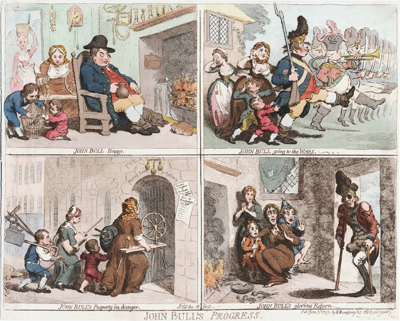
© Lewis Walpole Library, Yale University
Democracy follows a single character, Buonaparte, from childhood to his elevation as First Consul (and future Emperor) and anticipates his final retribution. So there is a strong forward movement as we trace his development to see how he has become what he is. But unlike John Bull's Progress, there is also a contrary sense of individuation, because each frame represents a brutally satiric view of a democratic state or value: Innocence, Humility, Gratitude, etc. Indeed most of these frames could have been separate prints. The detail is marvelous, and the series looks forward to a similar "Life" story, The Life of William Cobbett, Written by Himself (1809). But in that series, Gillray did, in fact, put each scene on a separate plate.
Democratic Innocence
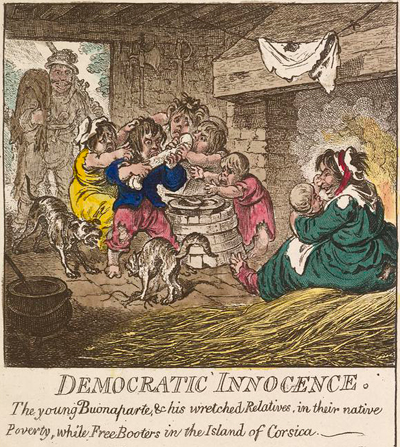
© Trustees of the British Museum
"Democratic Innocence" purports to show Buonaparte as a child growing up in large family in Corsica. There is no innocence here. Their home is a hovel. Their clothes are in tatters. The stewpot in the left foreground is empty. Napoleon fights with his siblings for control over the last, bare bone of food. The human struggle is duplicated in the confrontation of cat and dog as the cat protects his prey, an emaciated rat, from the incursion of the dog. The implication is that the humans here are scarcely better than animals.
Napoleon's father approaches the doorway, carrying a rifle and pistol with a very lean-looking deer slung across one shoulder which may provide at least temporary relief from the dire situation we see before us. On the back wall are other weapons, an axe and a sword, foreshadowing, perhaps, Napoleon's future career as a wielder of weapons in the military.
In fact, Napoleon DID come from a large family. Per Wikipedia, he "had an elder brother, Joseph, and younger siblings Lucien, Elisa, Louis, Pauline, Caroline, and Jérôme." But the Buonapartes were NOT poor. According to Robert Harvey, "they had an annual income of around £10,000 from their properties." And in "poverty-ridden Corsica, the Buonaparte's were considered well off." But Gillray's aim is not accuracy, but propaganda. And it serves that aim to portray Buonaparte as bred to be selfish and ruthless from childhood.
Democratic Humility
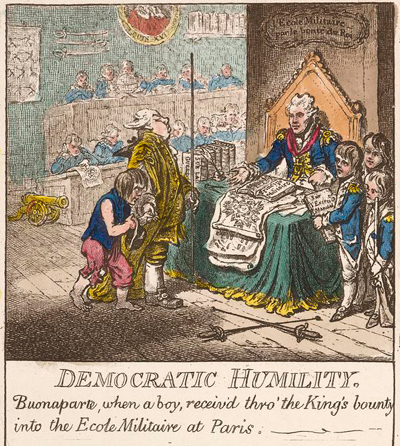
© Trustees of the British Museum
"Democratic Humility" seems to be a conflation of two separate events: Napoleon's arrival at the military school at Brienne-le-château in 1779 when he was nine, and his later admission to the Ecole Militaire in Paris in 1784. There are signs that this is a military school everywhere: the cannon in the background, the diagram of fencing positions on the wall, the titles on books and papers on the Commandant's desk and in the hands of other students, including "Sur la Guerre," "Principe Militaire," "Sur I'Exercise Manuel," and "Vauban," whose principles for fortifications were acknowldged standards in the field. Both Brienne and the Ecole Militaire were royal schools, so it is not surprising to see the image of King Louis XVI on the wall, nor is it accidental that Gillray shows (in a nice foreshadowing) his image beheaded by the top edge of the panel.
Napoleon's admission to the royal school at Brienne had been obtained through the influence of the Comte de Marbeuf, the French-appointed ruler of Corsica, his father's employer and his mother's (possible) lover. The large grey-haired man introducing the young Napoleon to the school's Commandant may, in fact, be intended to represent Marbeuf. But though Napoleon's youth and tattered clothes suggests that this is Brienne, the first military school he attended after leaving Corsica, the sign above the Commandant's chair and the caption below the image declare that it is the "Ecole Militaire at Paris."
The Ecole Militaire at Paris had been established by Louis XV. It had paying pupils as well as King's scholars whose tuition was covered, as Gillray indicates, by the "King's bounty." But admission to the Ecole and advancement beyond it was competitive; Napoleon was nominated for admission based on his work at Brienne and promoted to his first assignment after one year at the Ecole as a result of his scores on the examination. The crossed foils between himself and his fellow students may allude to this competition. And although Napoleon is shown with hat in hand, his gaze does not suggest humility but determination.
Democratic Gratitude
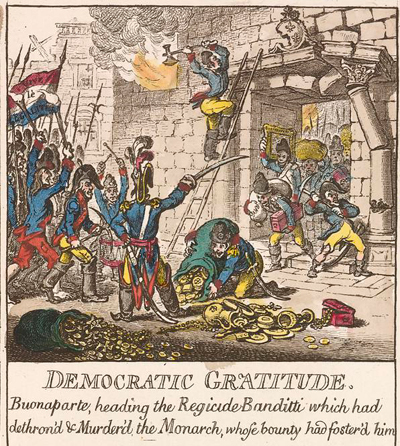
© Trustees of the British Museum
This panel portrays the first, really key event of Buonaparte's rise to power—when he was called upon by Paul Barras representing the French Directory to put down the Catholic/Royalist uprising in Paris on 13 Vendemiaire (October 5, 1795). Using his experience as an artillery officer, Napoleon identified and seized 40 cannons from the National Guards Artillery and positioned them at key locations around the Tuileries Palace where the members of the Directory were meeting. Having filled the cannons with lethal grape shot, Napoleon ordered his men to shoot into the crowd of French Royalists as they advanced upon the Palace, ruthlessly mowing down his countrymen, but almost certainly "saving" the Directory.
In Gillray's reformulation of the event, Napoleon is not so much a soldier, however, as he is a robber/banditti, with rank ingratitude betraying his obligations to the former monarch by having one soldier attack a royal crest above the door frame with an axe, while the rest of his troop ransacks the contents of the building.
Democratic Religion
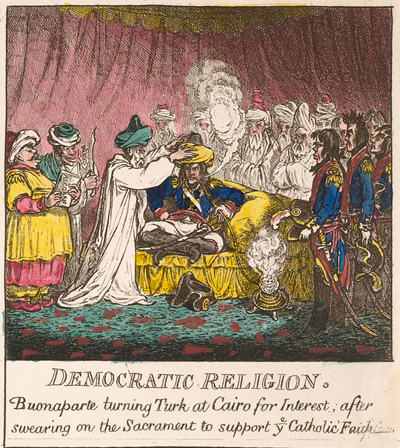
© Trustees of the British Museum
In keeping with his narrative of Napoleon's ruthless opportunism, Gillray in this plate shows Buonaparte after the conquest of Cairo making himself more acceptable to the natives by claiming to adopt Islam. Smoking a hookah and sitting cross-legged like some Pasha, he allows his French General's hat to be traded for a turban. While the ceremony proceeds, the Imam on Napoleon's right seems to be reciting verses from the Koran, while the man next to him tests the sharpness of the blade to be used for the ritual circumcision.
In fact, after much theological haggling, Napoleon "did obtain a fetwah, confirmed from Mecca, that the French were allies of Islam [but] were exempt from the rules of circumcision and abstention from alcohol" (Markham, p. 51),
Democratic Courage
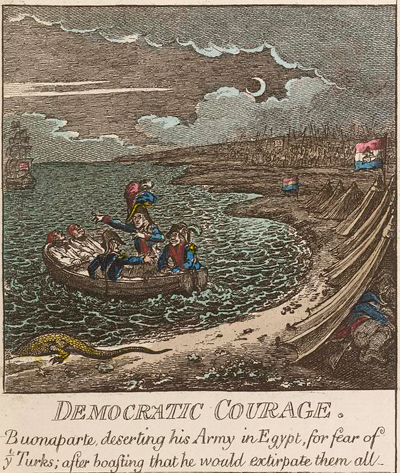
© Trustees of the British Museum
The next panel, "Democratic Courage," like Gillray's earlier print Buonaparte Leaving Egypt (March 8, 1800), shows Napoleon's unannounced and ignominious departure from Egypt. Over what appears to be the objections of one of his generals who points to the tents of the sleeping French troops, a shifty-eyed Napoleon is determined to press onward to a waiting ship.
This version of the episode makes Napoleon's desertion even more cowardly. In Buonaparte Leaving Egypt, the Turkish camp appears in the background, much larger than the French, but dormant. All the activity is in the French camp where the hapless troops are protesting Napoleon's departure. Here the French troops are sleeping while the Turkish troops are mounted on their horses poised to attack, their spears ready, and their symbol, the crescent moon, plainly ascendant in the night sky. Meanwhile in the foreground and parallel to Buonaparte's craft, a crocodile slithers away into the water.
Democratic Honor
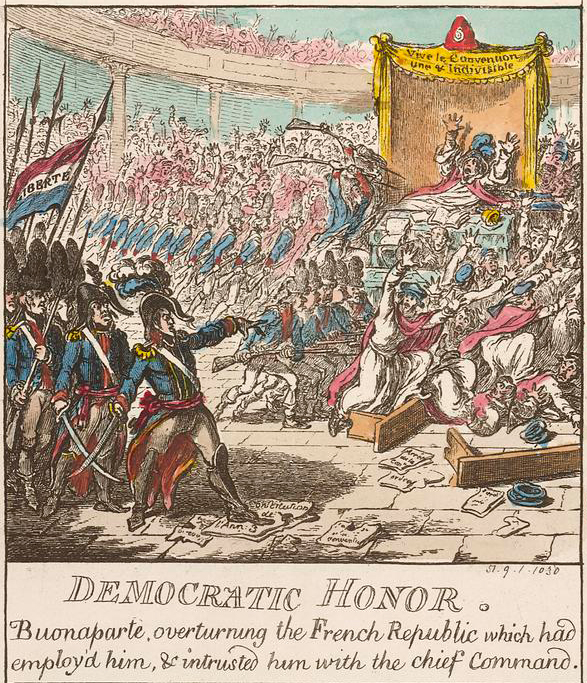
© Trustees of the British Museum
The panel, "Democratic Honor," revisits the scene portrayed in Gillray's earlier print, Exit Libertè a la Francoise! where Napoleon is shown, staging what was, in effect, a military coup, putting an end to the Directorate and establishing a Consulate with a new constitution. In the earlier print, the balance of pictorial power was still with the members of the convention. Napoleon and his troops are shown entering from the right, causing panic among the members, but occupying no more than a third of the image space. A wounded Napoleon, sword still sheathed, seems almost to call for calm and reassure them that they will not be harmed. In "Democratic Honor," on the other hand, the image allotment has been reversed. A much more dominant and aggressive Napoleon enters from the left, sword drawn, treading on the previous Constitution, and ordering his troops to attack with their guns and bayonets, driving the members of the Convention to the right third of the visual space and ultimately out of the panel view.
Gillray's caption correctly identifies the hypocrisy and dishonor of Buonaparte's actions. Responding to rumors of an imminent Jacobin coup, Napoleon and his troops had been "hired" to protect the members of the upper and lower councils from an armed takeover. Instead, they carried out one of their own.
Democratic Glory
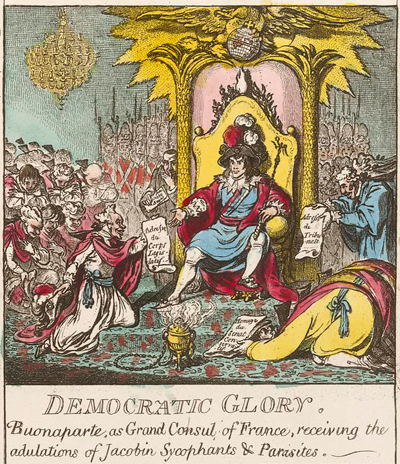
© Trustees of the British Museum
"Democratic Glory" picks up the story of Buonaparte's life at roughly the time of the actual Sketch. In May 1800, Napoleon was now first Consul. A new constitution with an executive branch of three Consuls had been written in December, largely by Buonaparte and the Abbe Sieyès who appears just behind the throne. In keeping with the classical themes loved by the Revolution, the new Constitution used titles derived from classical Rome, but for all intents and purposes, created a dictatorship with all power concentrated in the figure of the First Consul.
The new constitution also established a legislative branch of three houses: a Conservative Senate, a Tribunate, and a Legislative Body. Representatives of all three appear in Gillray's panel in servile positions, adressing or paying homage to the imperial First Consul while a thurible in the foreground burns reverential incense. In his hand he grasps a sceptre with what is likely an image of Victory holding up a wreath. Above his golden throne, an eagle grasps the symbolic orb of power which is also, in this case, a world globe. All of which is a long way from the democratic ideals of the original revolution.
Democratic Consolations
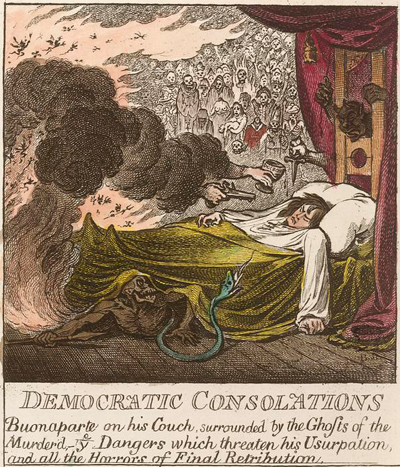
© Trustees of the British Museum
Dreams appear frequently in Gillray's work, and many of them are (to use Freud's term) anxiety dreams. Examples include Tom Paine's Nightly Pest (1792), and Duke William's Ghost (1799) to name just two. In this panel, Napoleon is having just such an anxiety dream, haunted, as the caption says, by the ghosts of those murdered during his rise to power, including the King and Queen, bishops and monks, arabs, and just plain citizens; by would-be assassins (there were 20-30 attempts during his lifetime); and by death, evil, and the flames of hell appearing from beneath the bed.
Sources and Reading
- Commentary from the British Museum on Democracy, or a Sketch of the Life of Buonaparte.
- Tim Clayton & Sheila O'Connell, Bonaparte and the British, 2015, #37, p. 91.
- Draper Hill, The Satirical Etchings of James Gillray, 1976, #69.
- "Napoleon," Wikipedia
- "13 Vendémiaire," Wikipedia
- "13 Vendémiaire: the day that made Napoleon," Real History
- "Sébastien Le Prestre de Vauban," Wikipedia
- "Constitution of the Year VIII," Wikipedia
- "Assassination attempts on Napoleon Bonaparte," Wikipedia
- Robert Harvey, The War of Wars, London, 2006.
- Felix Markham, Napoleon, New York, 1963.
- Thomas Wright and R.H. Evans, Historical and Descriptive Account of the Caricatures of James Gillray #252.
- Thomas Wright and Joseph Grego, The Works of James Gillray, the Caricaturist; With the History of His Life and Times, p. 268.
Comments & Corrections
NOTE: Comments and/or corrections are always appreciated. To make that easier, I have included a form below that you can use. I promise never to share any of the info provided without your express permission.